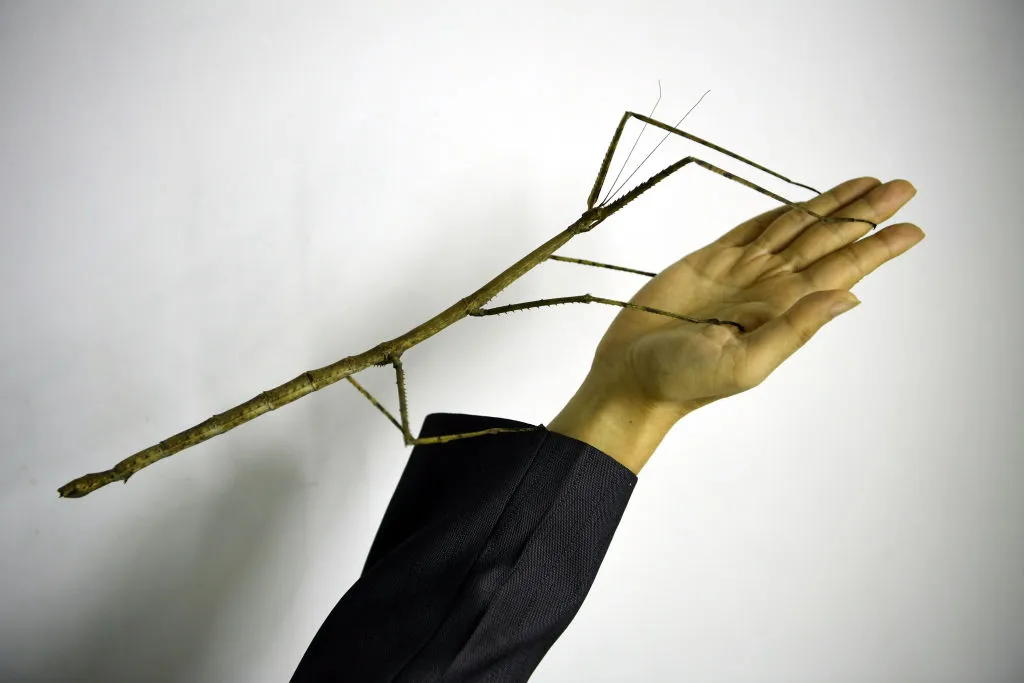Determining which insect is the largest is a tricky endeavour; the word large will mean many things depending on who you talk to. It could be the length of an insect or its weight, wingspan – maybe even general bulk.
Consequently, we’re going to have a look at a number of different species that could fall into the world’s largest insect category and leave it to you to decide which you think comes out on top!
Here are the contenders for world’s largest insect....
World’s largest insects
Giant Chinese stick insect - world’s longest insect

The world’s longest insect, and a worthy contender for biggest insect, is currently the giant Chinese stick insect (Phryganistria chinensis); discovered in China as recently as 2014. The adult female first found in the wild measured 624mm in length with legs outstretched, but was surpassed by one of its captive-bred young that reached 640mm in length! The jungle nymph stick insect (Heteropteryx dilatata) of Malaysia does not reach the same impressive lengths as its Chinese cousin, but is one of the chunkier ‘sticks’, and is often cited as one of the heaviest, reaching up to 65g in weight.
The blue-winged helicopter - world’s largest dragonfly or damselfly

The blue-winged helicopter (Megaloprepus caerulatus), a damselfly from the Central American rainforests, is the largest living member of the dragonfly and damselfly order, Odonata. With a body length of about 130mm and a wingspan of 190mm, it’s almost twice the size of the UK’s emperor dragonfly and makes an easy meal of its chosen prey, orb-weaver spiders, which it plucks straight from a spider’s web.
The Queen Alexandra’s birdwing - world’s largest butterfly

The Queen Alexandra’s birdwing (Ornithoptera alexandrae) is the largest butterfly in the world. It is found in eastern Papua New Guinea and adult females can have a body length of about 80mm and a wingspan slightly in excess of 250mm - definitely worthy of a place on the world's biggest insect list.
The Little Barrier Island giant wētā - world’s heaviest insect

The Little Barrier Island giant wētā (Deinacrida heteracantha) could also appear in the world’s largest insects list. Endemic to New Zealand, where it survives only on Little Barrier Island and some predator-free conservation areas that it has been translocated to, this relative of the grasshopper can measure up to 100mm in length. It is often cited as the heaviest insect in the world, with one captive female reaching a mass of 71g.
Royal Goliath beetle - world’s largest beetle

Many beetles reach great sizes but the royal Goliath beetle (Goliathus regius) is among the largest beetles, measuring up to 115mm in length. Found in western equatorial Africa, this Goliath of insects primarily feeds on tree sap and fruits, and despite its large size it can fly well. Goliath beetle larvae get even bigger and are capable of growing up to 250mm in length and reaching weights in excess of 100g!
- How big are beetles?
- Where do beetles live? The different places beetles thrive
- Why do beetles come in a variety of shapes?
- What do beetles eat?
Hercules beetle - world’s longest beetle
The longest beetle award could go to the Hercules beetle (Dynastes hercules), which lives from southern Mexico down to South America. Thanks to its great ‘horn’ it can measure up to 181mm in length. The Wallace’s long-horn beetle (Batocera wallacei) from New Guinea can grow to about 266mm in length, however, about 190mm of this is antennae.
World’s largest giant water bug

Giant water bugs (Belostomatidae) are a family of freshwater hemipteran insects or true bugs. Occurring worldwide, but with most species in the Americas, Australia and Asia, they are typically found (as their name would suggest) in or around water, namely freshwater streams and ponds. The largest giant water bugs can grow to more than 120mm in length.
The blue eyes lacewing - world’s largest lacewing

The largest lacewing is the blue eyes lacewing (Nymphes myrmeleonides), an Australian insect found in New South Wales and Queensland. This lacewing can measure up to 40mm in length and have a wingspan of about 110mm. As with dragonflies and damselflies, similar species existed during the Jurassic Period and also grew incredibly large. Partially preserved Makarkinia adamsi fossils suggest that this ancient species had a wingspan of between 140-160mm!
World’s largest insect ever
If we go back in time nearly 300 million years, the largest known insect was a predator resembling a dragonfly, but only distantly related to them. Meganeuropsis permiana had a body about 430mm long and a wingspan of an incredible 710mm (that’s nearly 1m). Their maximum body mass is uncertain, with estimates varying between 34g and 240g.
- Why were prehistoric insects so large?
- 10 biggest spiders in the world
- 5 of the biggest spiders in the UK: look for them in canals, gardens, ditches... and under your bed
Insects come in a variety of shapes and sizes, with new species being discovered on a regular basis – both living and fossilised. Given that the giant Chinese stick insect, despite its size, was only detected in recent years, is it possible that the world’s largest insect is yet to be discovered?
